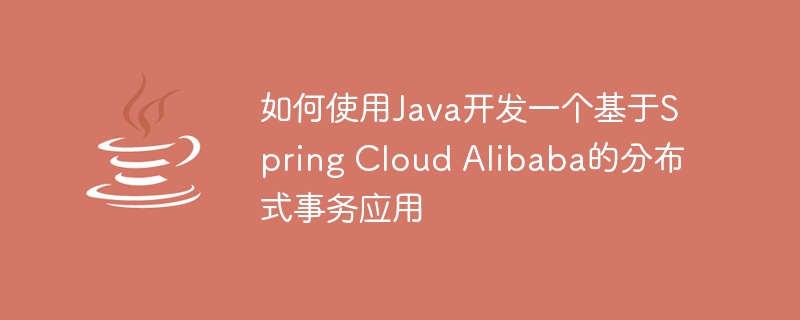如何使用Java開發一個基於Spring Cloud Alibaba的分散式交易應用
- PHPz原創
- 2023-09-21 13:13:41618瀏覽

如何使用Java開發一個基於Spring Cloud Alibaba的分散式交易應用程式
摘要:
分散式交易是在分散式系統中處理多個子事務的一種機制,確保這些子事務要麼全部成功,要麼全部回滾。在微服務架構中,由於服務間的相互調用,分散式事務成為一個具有挑戰性的問題。 Spring Cloud Alibaba是一個基於Spring Cloud的微服務開發框架,它提供了一套全面的分散式事務解決方案。本文將介紹如何使用Java開發一個基於Spring Cloud Alibaba的分散式交易應用,並提供具體的程式碼範例。
- 引入依賴
在使用Spring Cloud Alibaba進行分散式事務開發之前,我們首先需要引入對應的依賴。在專案的pom.xml檔案中加入以下依賴:
<dependency>
<groupId>org.springframework.cloud</groupId>
<artifactId>spring-cloud-starter-alibaba-seata</artifactId>
</dependency>- 設定Seata
Seata是Spring Cloud Alibaba中的分散式交易解決方案。我們需要在應用程式的設定檔中配置Seata的相關資訊。在application.properties或application.yml檔案中加入以下設定:
# 启用Seata的自动代理 spring.cloud.alibaba.seata.tx-service-group=my_tx_group # Seata的注册中心地址 spring.cloud.alibaba.seata.registry.type=consul spring.cloud.alibaba.seata.registry.address=127.0.0.1:8500
- #實作分散式交易
接下來,我們開始實作一個簡單的分散式交易範例。假設我們有兩個微服務:訂單服務和庫存服務。當一個訂單創建時,我們需要同時扣除相應的庫存。為了實現分散式事務,我們需要使用Seata提供的@GlobalTransactional註解。在訂單服務的建立訂單方法上加入註解如下:
@GlobalTransactional
public void createOrder() {
// 扣除库存的逻辑
deductStock();
}在庫存服務的扣除庫存方法上也加入@GlobalTransactional註解:
@GlobalTransactional
public void deductStock() {
// 扣除库存的逻辑
}- 實作本地事務
在上述範例中,我們使用了Seata來管理分散式事務。但實際上,我們仍然需要在每個微服務中實作本地事務邏輯。由於Seata支援多種分散式事務模式,我們可以選擇合適的模式來實現本地事務。
範例中的訂單服務和庫存服務可以使用JdbcTemplate或MyBatis來操作資料庫。我們在每個服務中定義一個本地事務方法,並透過@LocalTransactional註解來標記:
@LocalTransactional
public void createOrderTx() {
jdbcTemplate.update("INSERT INTO orders (order_id, user_id, amount) VALUES (?, ?, ?)", orderId, userId, amount);
}
@LocalTransactional
public void deductStockTx() {
jdbcTemplate.update("UPDATE stock SET amount = amount - ? WHERE id = ?", amount, stockId);
}- 測試分散式事務
現在我們可以測試一下我們的分散式事務應用。在測試程式碼中,我們建立一個訂單,然後斷言訂單和庫存的狀態是否符合預期:
@Test
public void testCreateOrder() {
// 创建订单
orderService.createOrder();
// 断言订单状态
Order order = jdbcTemplate.queryForObject("SELECT * FROM orders WHERE order_id = ?", new OrderRowMapper(), orderId);
assertNotNull(order);
assertEquals(userId, order.getUserId());
assertEquals(amount, order.getAmount());
// 断言库存状态
Stock stock = jdbcTemplate.queryForObject("SELECT * FROM stock WHERE id = ?", new StockRowMapper(), stockId);
assertNotNull(stock);
assertEquals(originalAmount - amount, stock.getAmount());
}總結:
本文介紹如何使用Spring Cloud Alibaba開發一個基於分散式事務的應用。透過引入Seata依賴,並在每個微服務的關鍵方法上加入@GlobalTransactional或@LocalTransactional註解,我們可以基於Spring Cloud Alibaba建立一個可靠的分散式事務應用程式。在實際專案中,也可能需要處理更複雜的分散式事務場景,例如分散式鎖定、訊息佇列等。希望本文對你理解和使用分散式事務提供了一些幫助。
以上是如何使用Java開發一個基於Spring Cloud Alibaba的分散式交易應用的詳細內容。更多資訊請關注PHP中文網其他相關文章!

